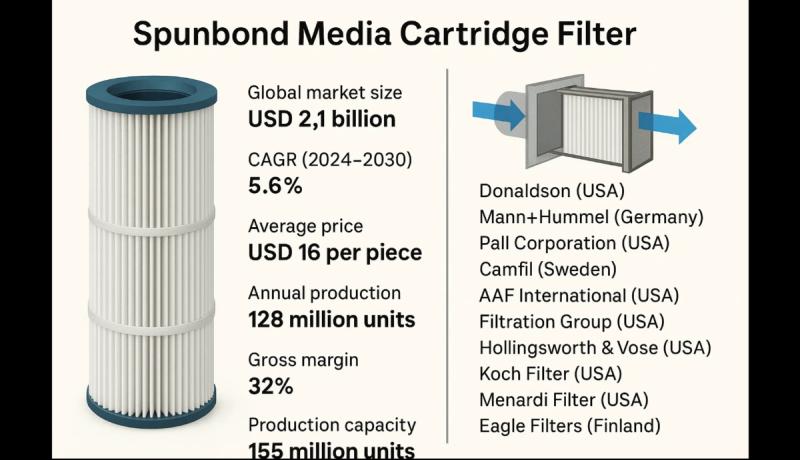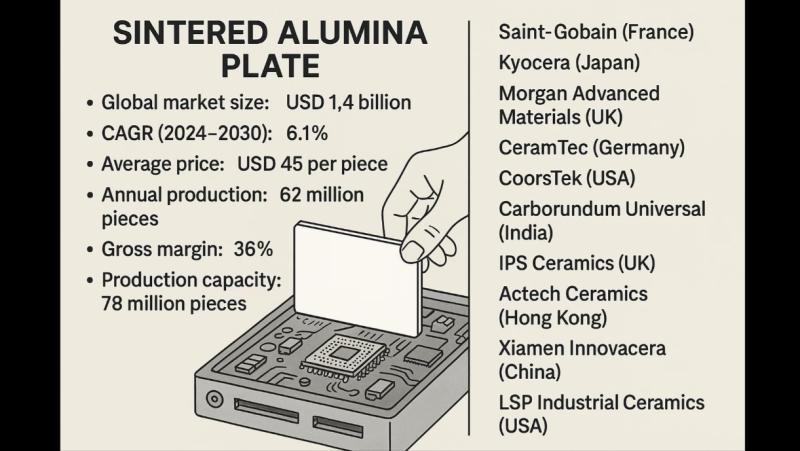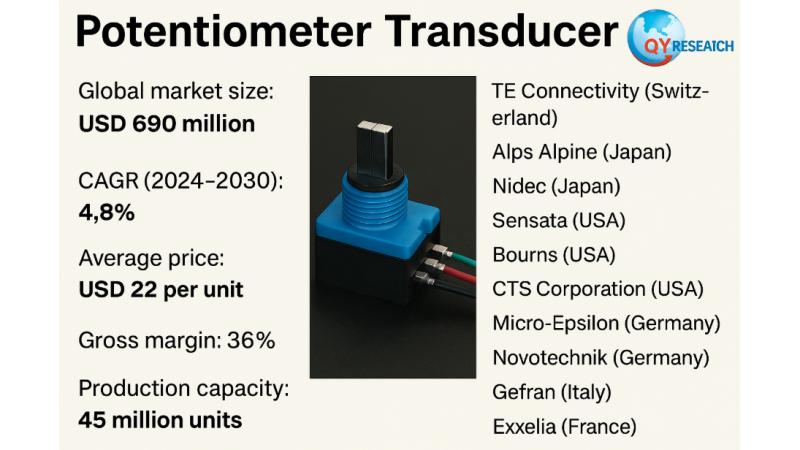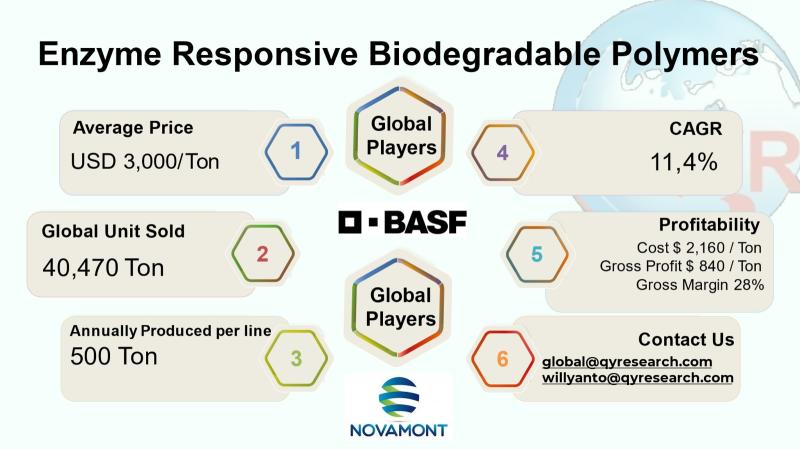Press release
The $121 Million Molecule: Inside The Enzyme Responsive Biodegradable Polymer Market Growing at 11.4% CAGR
Enzyme-responsive biodegradable polymers are a class of smart, degradable materials engineered to break down or change properties in response to specific enzymatic environments. These materials are increasingly applied where controlled degradation or triggered release is valuable for example in advanced medical devices, targeted drug delivery systems, active/functional packaging, and environmentally friendly single-use applications. The technology blends polymer chemistry with biological recognition (peptides, polysaccharides, enzyme-cleavable linkers), and the development pathway typically requires combined expertise in polymer manufacturing, enzymology and downstream formulation.The global enzyme-responsive biodegradable polymers market size in 2024 is USD 121 million with a forecast CAGR of 11.4% to 2031, reaching market size USD 259 million by 2031. With an average selling price at USD 3,000 per ton, the total global volume sold in 2024 is approximately 40,470 ton. A factory gross margin of 28%, which corresponds to a gross profit of about USD 840 per ton and cost of goods sold about USD 2,160 per ton. A COGS breakdown is raw materials, processing & energy, quality control & testing, R&D & formulation amortization, packaging, logistics & overhead. A single line full machine capacity production is around 500 ton per line per year. Downstream demand breakdown in healthcare & pharma ceutical followed by specialty packaging, agriculture, coatings and research/industrial uses.
Latest Trends and Technological Developments
Recent activity shows accelerating translation of enzyme-triggered concepts into applications and scale-up efforts. A Grand View Research market note and press release that frames the enzyme-responsive polymer segment and its growth drivers was published reporting the market sizing data in 2024. Academic and applied R&D through 2025 has advanced enzyme-responsive active packaging and fiber systems for example a 2025 ScienceDirect / journal article reported enzyme-responsive bacteriostatic fibers designed for on-demand release of active agents (2025). Technology adjacent to enzymatic polymer transformation is also moving forward: enzyme-based depolymerization breakthroughs (e.g., news in December 2024 about an enzyme able to break down certain nylons and enable new recycling strategies) illustrate the broader industrial interest in enzyme + polymer solutions and the investment appetite for enzyme-enabled circularity (Dec 2024). These enzymology breakthroughs de-risk aspects of industrial enzyme-polymer integration and influence investor interest. In parallel, larger biopolymers and smart polymer product launches from major chemical companies in 20242025 (noted in industry press) confirm that global producers are adding biodegradable and stimuli-responsive lines to their portfolios, which raises OEM supply options and affects pricing dynamics.
Novo Nordisk, a global leader in diabetes care, actively procures enzyme-responsive biodegradable polymers from Corbion N.V. for the development of next-generation drug delivery systems. These specialized polymers are purchased for use in subcutaneous implants and micro-particle formulations that release insulin or GLP-1 agonists in response to specific enzyme levels, such as those elevated during hyperglycemia. This targeted release mechanism allows for superior glucose control with fewer injections. Due to the high purity and precise engineering required for pharmaceutical applications, Novo Nordisk purchases these polymers at a premium cost, reflecting the significant R&D investment and value they add to advanced therapeutics.
Boston Scientific Corporation successfully applied the product in a medical device. They utilize an enzyme-responsive polymer coating on a specific line of bioresorbable vascular stents. Once implanted in a coronary artery, this stent provides mechanical support to keep the vessel open. Over time, inflammatory cells at the implantation site release specific enzymes (like matrix metalloproteinases) that gradually break down the polymer coating, releasing an anti-restenosis drug in a controlled, site-specific manner. After the artery has healed and the drug is fully eluted, the stent itself safely biodegrades, leaving no permanent metal implant behind. The use of this advanced polymer technology in each stent unit adds significant value, contributing to a product cost of over thousand dollars per unit for the healthcare provider.
Asia is a crucial and fast-growing market for enzyme-responsive biodegradable polymers because of scale, local feedstock availability, low-cost manufacturing, and active public policy in several countries promoting compostable/biodegradable substitutes. Asias broader bioplastics production capacity has been expanding strongly (global bioplastics capacity growth is projected in industry datasets), and large PLA and PHA investments in China and Southeast Asia are increasing feedstock-to-polymer supply. Major capacity additions in the region and rising local adoption in packaging and single-use replacements make Asia a strategic manufacturing base and the fastest growing demand region for many biodegradable polymer formats. Food packaging, single-use retail items, and medical disposables are the primary consumption vectors in Asia, with significant industrial and municipal interest in controlled-degradation solutions where composting or enzymatic degradation can be integrated. These regional capacity and investment trends are reported by European Bioplastics and industry capacity trackers.
Get Full PDF Sample Copy of Report: (Including Full TOC, List of Tables & Figures, Chart)
https://www.qyresearch.com/sample/5489130
Enzyme Responsive Biodegradable Polymers by Type:
Polyesters
Plyhydroxyalkanoates
Polysaccharide Based Polymers
Peptide
Others
Enzyme Responsive Biodegradable Polymers by Product Category:
Medical Grade
Food Contact Certified
Compostable
Enzyme Triggered Only
Others
Enzyme Responsive Biodegradable Polymers by Market Segment:
Pellets
Films
Foams
Hydrogels
Others
Enzyme Responsive Biodegradable Polymers by Features:
Enzyme Triggered Degradation
Controlled Drug Release Capability
Biocompatible and Non Toxic
Tunable Mechanical and Degradation Profile
Others
Enzyme Responsive Biodegradable Polymers by Usage:
Drug Delivery Systems
Tissue Engineering Scaffolds
Biodegradable Packaging
Agricultural Release Systems
Others
Enzyme Responsive Biodegradable Polymers by Application:
Healthcare and Pharmaceutical
Specilaty Packaging
Agriculture
Coatings
Others
Global Top 10 Key Companies in the Enzyme Responsive Biodegradable Polymers Market
Evonik Industries AG
Danimer Scientific
Kaneka Corporation
NatureWorks LLC
BASF SE
Tepha Inc
Newlight Technologies Inc
Novamont S.p.A
Lubrizol Corporation
Merck KGaA
Regional Insights
Southeast Asia is an increasingly attractive market both for manufacturing and adoption. ASEAN markets are characterized by fast consumer growth, packaging demand, and agricultural uses, and governments across ASEAN have raised targets for bioplastic adoption while investing in waste-management improvements. Indonesia in particular has been cited in market reports as one of the leading ASEAN growth centers for bioplastics, with market research houses forecasting strong CAGR and rising local projects and joint ventures to build local capacity. Indonesias combination of large domestic packaging demand, increasing consumer preference for sustainable packaging, and government interest in plastic pollution mitigation make it a key market to monitor. Industry research on Southeast Asia/Indonesia bioplastics supports these conclusions.
Commercialization of enzyme-responsive biodegradable polymers faces several recurring challenges. First, a materials performance vs. cost tradeoff: enzyme-sensitive chemistries and high-value functional groups tend to increase raw material and formulation costs versus commodity polymers, constraining broad replacement in low-margin segments. Second, standards, certification and end-of-life infrastructure are uneven across regions a polymer that is enzyme-digestible in one managed compost environment may not behave the same in a municipal landfill or in marine settings, and regulators and buyers demand certifiable performance. Third, scale-up risk: many enzyme-responsive formulations are born in lab or pilot scales and require process robustness and enzyme stability for continuous extrusion and downstream conversion. Fourth, supply chain and feedstock volatility (corn/sugar for PLA, fermentation feedstocks for PHA) can create cost pressure. Finally, IP and regulatory complexity around biomedical uses (if polymers target drug-delivery/implantable devices) raise barriers to market entry and lengthen time to revenue.
Companies seeking to enter or expand in enzyme-responsive biodegradable polymers should pursue three parallel playbooks: (1) strategic partnerships that combine polymer manufacturers with biotech/enzyme specialists (this lowers technical risk and accelerates modular productization of enzyme-triggered attributes); (2) vertical integration or long-term feedstock contracts to stabilize raw material costs; and (3) targeted entry into high-value segments (medical devices, controlled-release packaging for high-value perishables) where premium pricing offsets formulation complexity. M&A activity or co-development deals are likely to be the fastest route for firms that lack enzymology expertise; conversely, enzyme developers may be attractive acquisition targets for polymer majors seeking to add functionalized biodegradable offerings quickly. Companies should also prioritize certification and regional waste infrastructure partnerships (especially in ASEAN) to ensure the claimed environmental benefits are realized in practice.
Product Models
Enzyme responsive biodegradable polymers represent an advanced class of materials engineered to degrade selectively when exposed to specific biological enzymes.
Polyesters in this category degrade through enzymatic hydrolysis of ester bonds, often triggered by lipases, esterases, or cutinases. Notable products include:
EcoFlex® BASF: Biodegradable aliphaticaromatic copolyester film used for compostable packaging.
Ingeo PLA 2003D NatureWorks: PLA grade responsive to enzymatic hydrolysis for packaging.
Biocosafe PCL Corbion: Polycaprolactone grade used in medical devices with controlled enzymatic breakdown.
Purac® PLA Pharma Corbion: Medical-grade PLA designed for bioresorbable implant applications.
GreenPolyCap Perstorp: Enzyme-responsive PCL blend for specialty coatings.
Polyhydroxyalkanoates are naturally occurring biopolyesters synthesized by microorganisms and highly responsive to depolymerase enzymes. Notable products include:
Nodax PHA Danimer Scientific: Biopolyester responding to PHA depolymerases for compostable applications.
Biocyle PHB TianAn Biological Materials (China): PHB polymer with predictable enzymatic degradation.
Mirel PHA CJ Biomaterials: High-performance PHA for packaging and food-contact uses.
PHBH Kaneka: Enzyme-responsive PHA copolymer used in straws and films.
BluePHA Zhongke New Materials (China): Microbial-derived PHA with efficient enzyme hydrolysis.
Polysaccharide-Based Polymers these polymers utilize enzyme-sensitive glycosidic linkages, breaking down under amylases, cellulases, chitinases, and related enzymes. Notable products include:
ChitoClear® Primex: Chitosan polymer responsive to chitinase for biomedical uses.
AmyloFlex Roquette: Starch-based polymer for enzyme-degradable packaging films.
CelGreen Biocellulose Fibria: Cellulose-based polymers degradable via cellulases.
Hydagen® CMF BASF Care Chemicals: Cellulose matrix used in personal care with enzyme sensitivity.
ChitoHeal Medical G.T.C. Bio: Chitosan polymer for wound dressings with enzymatic resorption.
Peptide polymers degrade via protease-triggered cleavage, offering exceptional programmability and biocompatibility. They are widely explored for targeted drug delivery, tissue scaffolds, bioadhesives, and responsive nanomaterials. Notable products include:
PepGel® PG-Matrix PepGel LLC: Protease-responsive peptide hydrogel for 3D cell culture.
Self-Assemble Peptide RADA16® 3D Matrix Inc.: Peptide polymer used in tissue regeneration.
HydroMatrix Sigma-Aldrich (Merck): Peptide-based hydrogel responsive to enzymatic breakdown.
EnzoPep Scaffold Collagen Solutions: Protease-responsive peptide scaffold for tissue engineering.
PepNano Carrier Creative Peptides: Peptide polymer nanocarrier designed for protease-triggered release.
Enzyme-responsive biodegradable polymers represent a niche but fast-growing segment within the broader bioplastics and smart polymers landscape. With a global market size in 2024 of about USD 121 million and double-digit growth through 2031, the segment attracts R&D investment, strategic partnerships, and selective industrial scale-up. Asia and Southeast Asia are critical frontiers for volume growth and manufacturing scale, but regionally variable standards and infrastructure pose both risks and opportunities. Commercial success will favor players that combine polymer manufacturing scale, enzymology know-how, and close alignment with end-use certification and waste-management environments.
Investor Analysis
What investors should watch: investors should track (1) IP and enzyme-tech ownership (who controls core enzyme-cleavable chemistry), (2) strategic partnerships between polymer manufacturers and biotech firms, (3) announced capacity expansions in Asia (China, Thailand, Indonesia) that affect feedstock and price dynamics, and (4) regulatory/certification developments that materially expand or limit market access. How investors can use the information: combine the quantitative market sizing and margin economics with company-level technical strengths to evaluate acquisition targets, JV partners, or equity investments; pay attention to firms that offer scalable production lines and validated end-use certifications. Why this is important: enzyme-responsive polymers are an early but high-potential segment where premium pricing, application specificity (medical, active packaging) and sustainability narratives can deliver outsized returns if technical and regulatory risks are managed investors who identify validated, scaleable technologies with strong route-to-market can capture premium valuation multiples relative to commodity biopolymers.
Request for Pre-Order Enquiry On This Report
https://www.qyresearch.com/customize/5489130
5 Reasons to Buy This Report
Complete, focused sizing for enzyme-responsive biodegradable polymers.
Regional intelligence on Asia and ASEAN, including practical insights for Indonesia market entry and local demand drivers.
Manufacturing economics and line-capacity context that help model capex and gross margin scenarios.
Timely trends and technology updates with dated items that point to commercialization pathways and partnerships.
A curated list of the relevant industry incumbents and strategic recommendations tailored to investors and corporate strategists.
5 Key Questions Answered
What is the 2024 market size, unit volume and projected CAGR to 2031 for enzyme-responsive biodegradable polymers?
What are realistic factory economics (price/ton, COGS breakdown, gross margin, gross profit/ton)?
Where in Asia and Southeast Asia is demand and capacity growing fastest, and what are the implications for supply chains?
What are the latest technological and commercial developments that could accelerate commercial adoption?
Who are the major players and what partnership or M&A moves should investors monitor?
Chapter Outline
Chapter 1: Introduces the report scope of the report, executive summary of different market segments (by region, product type, application, etc), including the market size of each market segment, future development potential, and so on. It offers a high-level view of the current state of the market and its likely evolution in the short to mid-term, and long term.
Chapter 2: key insights, key emerging trends, etc.
Chapter 3: Manufacturers competitive analysis, detailed analysis of the product manufacturers competitive landscape, price, sales and revenue market share, latest development plan, merger, and acquisition information, etc.
Chapter 4: Provides profiles of key players, introducing the basic situation of the main companies in the market in detail, including product sales, revenue, price, gross margin, product introduction, recent development, etc.
Chapter 5 & 6: Sales, revenue of the product in regional level and country level. It provides a quantitative analysis of the market size and development potential of each region and its main countries and introduces the market development, future development prospects, market space, and market size of each country in the world.
Chapter 7: Provides the analysis of various market segments by Type, covering the market size and development potential of each market segment, to help readers find the blue ocean market in different market segments.
Chapter 8: Provides the analysis of various market segments by Application, covering the market size and development potential of each market segment, to help readers find the blue ocean market in different downstream markets.
Chapter 9: Analysis of industrial chain, including the upstream and downstream of the industry.
Chapter 10: The main points and conclusions of the report.
Related Report Recommendation
Global Enzyme Responsive Biodegradable Polymers Market Research Report 2025
https://www.qyresearch.com/reports/5489130/enzyme-responsive-biodegradable-polymers
Global Enzyme Responsive Biodegradable Polymers Sales Market Report, Competitive Analysis and Regional Opportunities 2025-2031
https://www.qyresearch.com/reports/5489127/enzyme-responsive-biodegradable-polymers
Global Enzyme Responsive Biodegradable Polymers Market Outlook, InDepth Analysis & Forecast to 2031
https://www.qyresearch.com/reports/5489128/enzyme-responsive-biodegradable-polymers
Enzyme Responsive Biodegradable Polymers - Global Market Share and Ranking, Overall Sales and Demand Forecast 2025-2031
https://www.qyresearch.com/reports/5489132/enzyme-responsive-biodegradable-polymers
Global Biodegradable Polymers Market Research Report 2025
https://www.qyresearch.com/reports/4195082/biodegradable-polymers
Global Biodegradable Polymer Foam Market Research Report 2025
https://www.qyresearch.com/reports/3800055/biodegradable-polymer-foam
Global Biodegradable Medical Polymer Market Research Report 2025
https://www.qyresearch.com/reports/4302324/biodegradable-medical-polymer
Global Soy-Based Biodegradable Polymer Market Research Report 2025
https://www.qyresearch.com/reports/3420730/soy-based-biodegradable-polymer
Global Biodegradable Polymer Packaging Market Research Report 2025
https://www.qyresearch.com/reports/4707516/biodegradable-polymer-packaging
Global Biodegradable Polymer Composite Market Research Report 2025
https://www.qyresearch.com/reports/3968314/biodegradable-polymer-composite
Contact Information:
Tel: +1 626 2952 442 (US) ; +86-1082945717 (China)
+62 896 3769 3166 (Whatsapp)
Email: willyanto@qyresearch.com; global@qyresearch.com
Website: www.qyresearch.com
About QY Research
QY Research has established close partnerships with over 71,000 global leading players. With more than 20,000 industry experts worldwide, we maintain a strong global network to efficiently gather insights and raw data.
Our 36-step verification system ensures the reliability and quality of our data. With over 2 million reports, we have become the world's largest market report vendor. Our global database spans more than 2,000 sources and covers data from most countries, including import and export details.
We have partners in over 160 countries, providing comprehensive coverage of both sales and research networks. A 90% client return rate and long-term cooperation with key partners demonstrate the high level of service and quality QY Research delivers.
More than 30 IPOs and over 5,000 global media outlets and major corporations have used our data, solidifying QY Research as a global leader in data supply. We are committed to delivering services that exceed both client and societal expectations.
This release was published on openPR.
Permanent link to this press release:
Copy
Please set a link in the press area of your homepage to this press release on openPR. openPR disclaims liability for any content contained in this release.
You can edit or delete your press release The $121 Million Molecule: Inside The Enzyme Responsive Biodegradable Polymer Market Growing at 11.4% CAGR here
News-ID: 4290421 • Views: …
More Releases from QY Research

Cleaner Water, Lower Costs: How Sargento Foods Solved Chronic Clogging with Spun …
Sargento Foods, a food-processing plant in Wisconsin struggled with frequent clogging and high differential pressure in its process-water filtration system. The existing cellulose-based filters degraded quickly under continuous flow, microbial exposure, and periodic wash cycles. As a result, the plant faced repeated shutdowns, reduced throughput, and rising replacement costs. To address this, the maintenance team upgraded to Spunbond Media Cartridge Filters, which use thermally bonded polypropylene (PP) fibers to form…

How SEMES Tripled Etching Chamber Lifetimes with Ultra-Pure Sintered Alumina Pla …
SEMES, a semiconductor equipment OEM in South Korea faced recurring thermal warping and particle contamination issues with metal heater plates used in plasma etching chambers. Under repeated high-temperature cycles (400-900 °C), the metal plates deformed, shed micro-particles, and caused process instability-leading to wafer defects and costly chamber downtime. To solve this, the company transitioned to Sintered Alumina Plates, high-purity (>99.5%) Al2O3 ceramic substrates produced through isostatic pressing, high-temperature sintering (>1,600…

Global and U.S. Potentiometer Transducers Market Report, Published by QY Researc …
A packaging automation company in Illinois encountered recurring positioning errors in its high-speed robotic carton-forming machines. The existing encoder system struggled with vibration, dust, and rapid reversals of motion, causing inaccurate arm positioning and frequent misfeeds. This resulted in jammed cartons, wasted material, and unplanned stoppages during peak production hours. To fix the issue, the engineering team adopted Potentiometer Transducers, linear and rotary displacement-measuring devices that use a precision resistive…

Global and U.S. Drag Racing Springs Market Report, Published by QY Research.
A professional drag racing team competing in NHRA Pro Mod repeatedly struggled with inconsistent 60-foot times and severe wheel hop during high-torque launches. Despite optimizing tire pressure and shock settings, the car suffered from uncontrolled rear suspension squat that caused traction loss and unpredictable deviations off the starting line. After analyzing high-speed launch footage, the crew identified that the stock performance springs were collapsing too quickly under the vehicle's instantaneous…
More Releases for Enzyme
Enzyme Replacement Therapy Market: Advancing Treatment for Inherited Enzyme Defi …
The Enzyme Replacement Therapy Market at a global level was worth USD 10.1 Billion in 2022 and is anticipated to expand to USD 20.6 Billion by 2032, experiencing a CAGR of 7.6% during the forecast period of 2023-2032.
The Enzyme Replacement Therapy (ERT) Market stands at the forefront of medical innovation, offering transformative treatment options for individuals with inherited enzyme deficiencies. Enzyme replacement therapy involves the infusion of artificial enzymes into…
Anti-Inflammatory Activity Enzyme and Protease Enzyme | Pearlzyme Inc
Pearlzyme Inc. focuses on boosting animal immune systems against infection and increasing milk lactation with anti-inflammatory activity enzymes. Also enzyme feed additives demonstrates a commitment to improving animal health and productivity. By developing innovative products, the company aims to provide effective solutions to its customers.
Pearlzyme Inc is committed to sustainable development and reducing environmental impact. As an environmentally conscious company, it recognizes the importance of minimizing its footprint and contributing…
Meat Tenderizing Agents Market 2018 Flourishes with International Prestigious Pl …
Market Overview:
Tenderizing is a process so as to to reduce the toughness of meat fibers in a cut of meat. Tenderizing agents breaks down the meat collagen and softens the meat. The tenderness of meat depends on various factors including the meat grain, the amount of connective tissue, and the fat %. Tenderness can be improved by various techniques, generally enzymes and acids are used in this process. Enzymes…
Meat Tenderizing Agents Market 2018 Flourishes with International Prestigious Pl …
Market Overview:
Tenderizing is a process so as to to reduce the toughness of meat fibers in a cut of meat. Tenderizing agents breaks down the meat collagen and softens the meat. The tenderness of meat depends on various factors including the meat grain, the amount of connective tissue, and the fat %. Tenderness can be improved by various techniques, generally enzymes and acids are used in this process. Enzymes…
Meat Tenderizing Agents Market Global Leader | Enzyme Bioscience Pvt. Ltd, AB En …
Market Overview:
Tenderizing is a process so as to to reduce the toughness of meat fibers in a cut of meat. Tenderizing agents breaks down the meat collagen and softens the meat. The tenderness of meat depends on various factors including the meat grain, the amount of connective tissue, and the fat %. Tenderness can be improved by various techniques, generally enzymes and acids are used in this process. Enzymes…
Enzymes in Biofuel Market Research Report 2018 | Biofuel Enzyme, Schaumann Bioen …
Researchmoz added Most up-to-date research on "Global Enzymes in Biofuel Market Research Report 2018" to its huge collection of research reports.
This report studies the global Enzymes in Biofuel market status and forecast, categorizes the global Enzymes in Biofuel market size (value & volume) by key players, type, application, and region. This report focuses on the top players in North America, Europe, Asia-Pacific, South America, and Middle East & Africa.
The…
